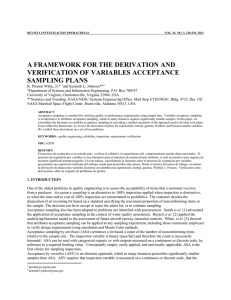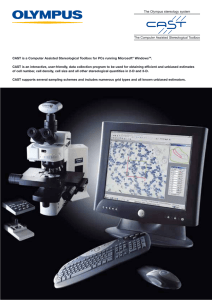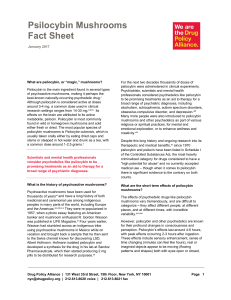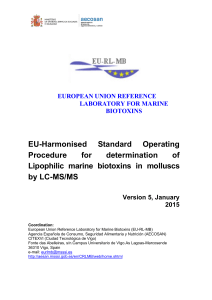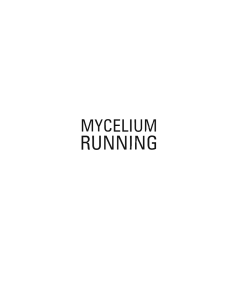A sampling method for estimating sporocarps production of
Anuncio
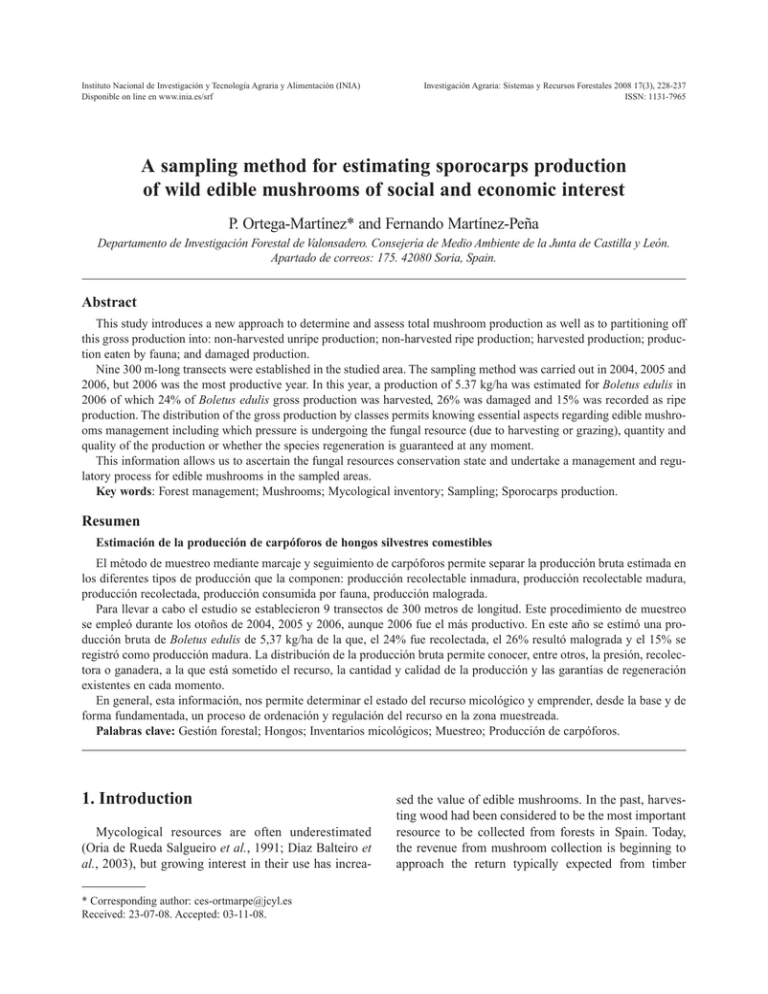
Instituto Nacional de Investigación y Tecnología Agraria y Alimentación (INIA) Disponible on line en www.inia.es/srf Investigación Agraria: Sistemas y Recursos Forestales 2008 17(3), 228-237 ISSN: 1131-7965 A sampling method for estimating sporocarps production of wild edible mushrooms of social and economic interest P. Ortega-Martínez* and Fernando Martínez-Peña Departamento de Investigación Forestal de Valonsadero. Consejería de Medio Ambiente de la Junta de Castilla y León. Apartado de correos: 175. 42080 Soria, Spain. Abstract This study introduces a new approach to determine and assess total mushroom production as well as to partitioning off this gross production into: non-harvested unripe production; non-harvested ripe production; harvested production; production eaten by fauna; and damaged production. Nine 300 m-long transects were established in the studied area. The sampling method was carried out in 2004, 2005 and 2006, but 2006 was the most productive year. In this year, a production of 5.37 kg/ha was estimated for Boletus edulis in 2006 of which 24% of Boletus edulis gross production was harvested, 26% was damaged and 15% was recorded as ripe production. The distribution of the gross production by classes permits knowing essential aspects regarding edible mushrooms management including which pressure is undergoing the fungal resource (due to harvesting or grazing), quantity and quality of the production or whether the species regeneration is guaranteed at any moment. This information allows us to ascertain the fungal resources conservation state and undertake a management and regulatory process for edible mushrooms in the sampled areas. Key words: Forest management; Mushrooms; Mycological inventory; Sampling; Sporocarps production. Resumen Estimación de la producción de carpóforos de hongos silvestres comestibles El método de muestreo mediante marcaje y seguimiento de carpóforos permite separar la producción bruta estimada en los diferentes tipos de producción que la componen: producción recolectable inmadura, producción recolectable madura, producción recolectada, producción consumida por fauna, producción malograda. Para llevar a cabo el estudio se establecieron 9 transectos de 300 metros de longitud. Este procedimiento de muestreo se empleó durante los otoños de 2004, 2005 y 2006, aunque 2006 fue el más productivo. En este año se estimó una producción bruta de Boletus edulis de 5,37 kg/ha de la que, el 24% fue recolectada, el 26% resultó malograda y el 15% se registró como producción madura. La distribución de la producción bruta permite conocer, entre otros, la presión, recolectora o ganadera, a la que está sometido el recurso, la cantidad y calidad de la producción y las garantías de regeneración existentes en cada momento. En general, esta información, nos permite determinar el estado del recurso micológico y emprender, desde la base y de forma fundamentada, un proceso de ordenación y regulación del recurso en la zona muestreada. Palabras clave: Gestión forestal; Hongos; Inventarios micológicos; Muestreo; Producción de carpóforos. 1. Introduction Mycological resources are often underestimated (Oria de Rueda Salgueiro et al., 1991; Díaz Balteiro et al., 2003), but growing interest in their use has increa* Corresponding author: ces-ortmarpe@jcyl.es Received: 23-07-08. Accepted: 03-11-08. sed the value of edible mushrooms. In the past, harvesting wood had been considered to be the most important resource to be collected from forests in Spain. Today, the revenue from mushroom collection is beginning to approach the return typically expected from timber Estimating sporocarps production of wild edible mushrooms (Marraco and Rubio, 1992). The harvesting and selling of edible wild mushrooms aid rural development (Boa, 2004) by providing an additional source of income for local inhabitants. According to a recently published FAO study, 2166 species of wild edible mushrooms are known worldwide and 470 more have medicinal properties. This clearly demonstrates the economic importance of the mushrooms and their relevance as a food source (Boa, 2004). Edible wild mushrooms are harvested, consumed and marketed in more than 80 countries worldwide, with several million tonnes harvested annually, valued at up to 2 billion dollars (1.35 billion euros) (Boa, 2004). On the Iberian Peninsula, the amount of commercially harvested Boletus edulis species complex has risen to 8,000 tonnes and the amount of Lactarius deliciosus to 20,000 tonnes (Oria de Rueda Salgueiro, 1989). In Castilla y León the average gross annual production for edible wild mushrooms of social and economic interest was been estimated to be 34,000 tonnes (excluding the Tuber genus), produced in an area of 4.5 million hectares (Martínez-Peña et al., 2007). About 54% of the population in Castilla y León picks mushrooms that means a potential of 567,715 local harvesters (Martínez-Peña et al., 2007). Taking into account this potential harvest capacity for the region, up to 65 million euros could be generated as direct incomes for the local harvesters by marketing the main commercial species. Mushrooms also feature on the menus of 55% of restaurants in rural areas of Castilla y León and 54% of accommodations in rural areas have mushrooms harverters among their clients (Martínez-Peña et al., 2007). These figures clearly show the important role that mushroom harvesting and myco-tourism play in the social and economic development of rural areas in Castilla y León. The growing value of mycological resources has caused an increase in the amount of mushroom harvesters who often exploit the resources to such an extent that the mycological productivity and diversity becomes endangered (Arnolds, 1991; Boa, 2004). In spite of this, there are some authors who believe the impact of mushroom harvesting on sporocarp production is insignificant (Egli et al., 2006). Faced with this situation of endangerment it is necessary to begin a process leading to the sustainable exploitation of the resource, based on studies aimed at obtaining exhaustive knowledge about the biology, ecology and productivity of edible wild mushrooms of social and economic interest in the region (López et al., 2005). 229 Quantifying the production of wild mushrooms through mycological inventories is essential in order to identify the communities of fungal macrocmycetes in the sampled area. The production of sporocarps is influenced by a multitude of biotic and abiotic factors that considerably vary though time and space. This lack of uniformity in production makes the design and the performance of mycological inventories difficult and obligates to adapt the sampling procedure to the conditions of the area, the species sampled and the sampling objectives (Vogt et al., 1992). All studies about production and diversity of mushroom populations and communities rely on an inventory stage centred on sporocarps (Ohenoja, 1988; Peter et al., 2001; Taylor, 2002; Egli et al., 2006), mycorrhizae (de Roman and de Miguel, 2005), sporocarps and ectomycorrhizae (Clavería, 2007) or mycelium in the soil (Suz et al., 2006; Parladé et al., 2007). Methods used in sporocarps inventories varie according to the different authors and the peculiarities of their studies, but sampling units used are mainly plots and transects. Fenced plots are used to estimate mycological gross production since there are no external influences (Ohenoja, 1989; Bonet et al., 2004; Fernandez-Toiran et al., 2006). Otherwise, line-transect method are often used in mycological inventories because of its high spatio-temporal variability (Wilkins and Patrick, 1939). Usually, sampling efficiency is related to the size of the sampled area. As transects sampled area is greater than plots the sampling efficiency is also greater (Richardson, 1970). The objective of this study is to propose a sampling method for estimating mycological production, based on permanent transects of variable width and on marking and monitoring all found sporocarps. Unlike other sampling methods, our methodology allows for the break down of gross production and gives detailed information about the state of the resource. Other easier and more economical methods to manage the main edible wild mushroom species of social and economic interest could be develop from the information generated with this sampling method. The aspects that we must take into account are: 1. Harvesting and grazing pressure: when present, pressure from mushroom harvesters and livestock need to be identified and considered in order to better estimate the gross production and assess current state of conservation of the mycological resource. 2. Width of transect: to set the maximum width for all the sporocaps to be detected. 230 P. Ortega-Martínez et al. / Invest Agrar: Sist Recur For (2008) 17(3), 228-237 2. Materials and Methods 2.1. Description of the study area The sampling method was used in transects located on the thalwegs of Pinar Grande, a public forest situated in the northern part of the Sistema Ibérico mountain range, in the region of Pinares (Soria). The study area is comprised of 1,749.6 hectares of pure Scots pine (Pinus sylvestris L.) stands. Pinar Grande has over 12,500 ha and constitutes a basin of gentle orography, is orientated from west to east and varies in altitude from 1,097-1,543 m. The parent materials of the forestland area comprise siliceous conglomerates, quartzite and sandstone from the Lower Cretaceous period. Soils are brown acid, ferriluvic or ferriargiluvic, with a pH range of 3.8 to 5.6, of a sandy to sandy loam texture with low water retention properties and low soil fertility. Phytoclimatically it belongs to the true nemoromediterranean subtype VI(IV)2 (Allué, 1990). Average annual precipitation, according to data from the meteorological station “El Amogable”, is 864.8 l/m². Average annual temperature measured at “El Amogable” is 8.8ºC. According to the 2007 livestock census, Pinar Grande is home to 600 cattle and 700 sheep that graze freely over an area of 6,500 ha. Therefore, the pressure due to livestock in Pinar Grande is therefore 11 cattle unit/km2. In addition, pressure from game animals amounts to 2.53 roe deer/km2 and 0.94 wild boar/km2 while deer is nearly absent (Calvo Vacas and Díez Martínez, 1990). The pressure from mushroom harvesters varies annually; in 2006 the average daily amount measured over a weekend was nine harvesters/km2, rising to a maximum of 21 harvesters/km2, calculated by following the methodology of Martínez-Peña (2003). 2.2. Sampling This sampling method is valid for all species of epigeous macromycetes, although in practice and due to the laboriousness of data collection, the sampled species were those of greater social and economic interest in the study area. In the case of Pinar Grande, the sampled species was Boletus edulis due to its economical importance in the county. Hypogeous species were not sampled. Nine permanent transects measuring 330 m in length were established. The distribution of the sample units was carried out using random and stratified sampling (de Vries, 1986). Stratification was based on forest age so three transects were placed in each differently aged stand (<30 years; 31-70 years; >71 years) and were sampled weekly throughout the autumn, from September to November, for three years (2004, 2005 and 2006). Each transect was established with numbered trees, in such a way that from each tree along the transect both the next tree and the previous one were visible. Each transect was defined by the central line, that is, the imaginary line that links the consecutive trees. The width of each transect varies, amongst other factors, according to the species, the slope or the density of the shrub strata. This width can be calculated from all sporocarps positions after sampling had been carried out. Each colony, sporocarps separated among themselves less than 1.5 m, must be located by measuring the distances between the colony itself and both of the trees between which it is situated, taking into account if it is found on the right or the left of the central line of the transect. As the transects are permanent, the distances between every two consecutive trees along the transect were fixed and are measured when the transects were set up. In this way a triangle is formed whose vertices coincide with the sporocarp colony and also the two trees along the transect between which the colony is found. With these parameters and Heron’s formula, which determines the area of a triangle if the three sides are known, the perpendicular distance from the colony to the central transect line (d) can be calculated. p= a+b+c 2 r= (p a )* ( p b )* ( p c ) p d= 2*r * p c Where “a” and “b” are the distances between each colony and both of the trees between which it is situated and “c” is the distance between two consecutive trees. The calculation of the width of the transects is based on the detectability of the sampled species. Emlen’s method is used to set the detectability coefficients in terrestrial vertebrate census (Tellería, 1986). The different perpendicular distances calculated for each species are analysed to set a band series of the same width where the detectability diminishes from the first band to the last band. This method assumes that all colonies will be seen in the first band and none will be found any further than the maximum distance of the outermost band. 2.3. Description of the sampling procedure The main peculiarity of this sampling method consists in the marking, locating and monitoring of the Estimating sporocarps production of wild edible mushrooms 231 sporocarps seen to know their development over time. Each transect is sampled by locating all the specimens of the mushrooms species found on either side of the central line, regardless of the distance they are found. Once each sporocarp has been sighted data are collected in the following way: The sporocarp is firstly identified by two numbers, one indicating the colony to which it belongs and the other numbering each sporocarp. This identification is used to label a small stake poked in the ground next to the sporocarp. The size of the sporocarp cap is then measured in cm and, if necessary, how ripe it is. The distance is measured from the centre of the colony to each one of the two trees between which the colony has been located. It is also noted if the sporocarp is found to the right or to the left of the central line of the transect. The recorded sporocarps in the previous sampling should be located to register their evolution, including: the diameter and ripeness if the specimen has continued to develop; recording it as damaged if it has been trampled on, has diminished in size or has been half eaten; or the cause of its disappearance if it cannot be found (harvested or eaten by fauna), as detailed in Table 1. representative sample of sporocarps of the sampled species, selected at different stages of development in the study area. The average weight of a sporocarp will be calculated with the same sample. The average weight and standard error for Boletus edulis is 126±8 g in stands under than 30 years old, 65±3 g in stands understood to be between 31 and 70 years of age and 79±6 g in stands over 71 years old (Ortega-Martínez, 2005). This sampling method demands a precise division based on the sporocarps ripeness. Ripeness is determined by the spore print. Ripeness can be determined in some species with a change in the colour of the hymenium, while in other species sporulation experiments must be carried out in order to obtain the same outcome. A sporulation experiment is performed using a sample of sporocarps placed with the hymenium facing downwards on a piece of card with a colour that contrast with the spores of the studied species. After a 24 hour period the level of sporulation of each sporocarp can be observed. By relating this parameter with the sporocarp cap diameter a division between ripe and unripe according to the cap diameter is obtained. Boletus edulis shows a change in the colour of the hymenium, so white hymenia indicate an unripe state, while greenish-yellow hymenia are characteristic of ripe specimens. 2.4. Diameter-weight regression and determining ripeness 2.5. Calculating production The sporocarps remain on the study site because they are never collected by the samplers. The weight of each sporocarp is therefore obtained from the cap diameter by using linear regressions (Ohenoja, 1984). These regressions are obtained from the biometric study of a Table 1. Signs to explain sporocarp disappearence and to identify the agent involved TYPE OF PRODUCTION SIGNS-OBSERVATIONS Harvested production - Remains of the mushroom left when cleaned by harvesters. - Mushroom stalk cleanly cut by a knife. - Absence of sporocarp without signs of having been consumed by livestock. Production eaten by fauna - Ground/top layer disturbed. - Remains of an eaten sporocarp. - Teethmarks on stalk/cap of the mushroom. The gross mycological production (PB), in kg/ha, estimated with this sampling method is divided into a group of addends that separate it into other types of production (see Figure 1): PBi = pi + Pi + Ri + Gi + Mi (1) Where PBi is the gross production estimated for week i; pi is the unripe non-harvested production in week i; Pi is the ripe non-harvested production in week i; Ri is the harvested production in week i; Gi is the production eaten by fauna in week i and Mi is the damaged production (trampled, parasitised, uprooted, senescence, etc.) in week i. Each one of these addends can also be subdivided into some groups of components. The unripe non-harvested production in week i, measured in kg/ha, can be expressed by the following formula: pi = p ii + p ‘i(i-1) + ( p‘ii - p ‘i(i-1) ) (2) 232 P. Ortega-Martínez et al. / Invest Agrar: Sist Recur For (2008) 17(3), 228-237 Figure 1. Descriptive setup of the sampling method and its calculation procedure. In the figure, the sporocarps have been numbered and their weight is considered in the formula. Where pii is the weight of the new unripe specimens sighted in week i; p’i(i-1) is the weight in week (i-1) of the sporocarps observed as unripe that week and remained unripe in week i; (p’ii - p’i(i-1)) is the difference in weight between week i and week (i-1) of the specimens observed as unripe in week (i-1) and remained unripe in week i, thus obtaining the increase in weight from one week to another. The ripe non-harvested production (Pi) for week i measured in kg/ha can be calculated as: obtaining the increase in weight from one week to another. Bearing in mind the work of Egli (Egli et al., 2006) it has been accepted that sexual regeneration of Boletus edulis is ensured if at least 20% of the gross production remained in situ as Pi. The harvested production (Ri) for week i is expressed as: Pi = P ii + P‘i(i-1) + ( P‘ii - P‘i(i-1) ) Where r’i is the weight of the sporocarps observed as harvested in week i and registered the previous week, taking into account the weight they had in week (i-1); ri are the new specimens observed as harvested in week i, but not previously registered. As these specimens are absent, each one is considered to have the average weight of a sporocarp for each species. It is accepted that there will be a certain amount of specimens harvested in week i that remain undetected due to the lack of (3) where Pii is the weight of the new ripe specimens sighted in week i; P’i(i-1) is the weight in week (i-1) of the sporocarps observed as ripe or unripe that week and remained ripe or ripened during week i; (P’ii-P’i(i-1)) is the difference in weight between week i and week (i-1) of the specimens observed as ripe or unripe in week (i1) and remained ripe or ripened during week i, thus Ri = ri + r’i + kr * ( p ii - Pii ) (4) Estimating sporocarps production of wild edible mushrooms any sign of harvesting. To estimate this amount, kr is calculated, which is the percentage of the number of sporocarps observed in week (i-1) that were harvested in week i. This percentage will be applied to (pii + Pii) which represents the non-harvested production of new sporocarps observed in week i (regardless of those observed in previous weeks). In the same way as harvested production, production eaten by fauna (Gi) can be expressed as: Gi = gi + g’i + kg * ( p ii + P ii ) (5) Mi = m ii + m ‘i(i-1) By analysing the perpendicular distances (PD) of the 136 colonies found it is observed that within a 2 m width either side of the transect all present sporocarps are detected thus the detectability coefficient (DC) is 1. Taking the 2 m width, four bands within the belt transect were set up, as it is considered that beyond 8m no individuals are detected (DC=0). The overall detectability coefficient for Boletus edulis for a width of 8m either side of the transect is 0.53 and corresponds to the following function of detectability (see figure 2): CD = (1.04871 – 0.128589 * PD)2 The equation for damaged production (Mi) is: (6) The addend mii is equivalent to the sporocarps that are observed in week i as damaged (trampled on, parasitised, uprooted, etc) and were not previously registered, assigning them the average weight for each species, as in the previous cases. Likewise, m’i(i-1) are the specimens that were registered the previous week (i-1) and were found as damaged (dry, trampled or become maggoty) in week i, taking into account the weight of this same specimen the previous week. In order to obtain the value of the gross autumnal production, the terms corresponding to previous weeks (p’i(i-1) y P’i(i-1)) as well as the increases that the sporocarps present from one week to another ((p’ii - p’i(i-1)) y (P’ii - P’i(i-1))) must be taken away from the gross weekly production to avoid productions accumulations, obtaining the following equation: 233 (R2 = 98%) where CD is the cap diameter and PD is the perpendicular distance. The cap diameter-weight regression employed for the conversion of sporocarps of Boletus edulis was (Martínez-Peña, 2003): weight(g) = (1.4477 + 1.19504 * cap_diameter(cm))2 The average gross production obtained (see equation 1) was 5.37 ± 1.33 kg/ha. This gross production is divided in unripe and ripe non-harvested production, harvested production, eaten and damaged production (see figure 3). It has been estimated that 24% of the production of Boletus edulis in Pinar Grande is harvested, while 26% of the gross production became damaged. Only 15% of the gross production of Boletus edulis was recorded as ripe production capable of sexual regeneration of the species in the forest. PB = ∑ P ii + ∑ p ii + (ri + kr * (p ii + P ii ) + ∑ (gi + kg (p ii + P ii ) + ∑ m ii (7) 3. Results The sampling procedure was used on the Boletus edulis species complex only during the autumn (mycological production in autumn is the highest one of the year) of 2004, 2005 and 2006 on nine transects located in Pinar Grande. Only 2006 information has been considered in this section since mycological production in 2004 and 2005 was very poor. A total of 136 colonies were located with a total of 200 sporocarps of Boletus edulis of which 170 were observed in a good state or damaged, the rest were recorded as harvested (22 sporocarps) or eaten by fauna (8 sporocarps). Figure 2. Function of detectability for Boletus edulis in Pinar Grande for a transect width of 8 m. The outermost lines represent the 95% upper and lower confidence limits. 234 P. Ortega-Martínez et al. / Invest Agrar: Sist Recur For (2008) 17(3), 228-237 1.54 28% 1.37 26% regeneration (percentages of gross production higher than 20%). 4. Discussion 0.39 7% 0.79 15% 1.29 24% Non-harvested Unripe Production Non-harvested Ripe Production Harvested Production Production Eaten by Fauna Damaged Production Figure 3. Percentage distribution of average gross production (kg/ha) of Boletus edulis in Pinar Grande. The weekly changes in mushroom production depicted in figure 4 indicate that the weeks during which the production of Boletus edulis was higher coincided with those in which the highest number of mushrooms were harvested, showing the largest influx of harvesters occurred when the production was at its highest levels. According to Table 2, only weeks 43, 46 and 47 had high enough non-harvested production to guarantee The proposed sampling method allows to estimate the gross production of the study area and to separate it into perfectly defined different types of production. As well as the considerable temporal and spatial variation inherent to fungal fructification, other factors can lead to a quite substantial underestimation of production if not duly taken into account. These factors are harvesters and fauna essentially. Authors such as Richardson (1970), Ohenoja (1984), Ohenoja et al. (1984), Mehus (1986) and Hunt and Trappe (1987) highlighted that both agents should be taken into consideration when quantifying mycological production in a forest. The novelty of this sampling method is that the gross production is separated into its main components. Gross production is easily estimated by using plots and transects with different characteristics (Richardson, 1970; Vogt et al., 1981; Ohenoja and Koistinen, 1984; Mehus, 1986; Ohtonen, 1986; Luoma et al., 2004; Bonet et al., 2004; Kranabetter et al., 2005), although fenced plots are the best way to estimate this production mainly in areas where grazing and harvesting pressures are high (Ortega-Martínez and Martínez-Peña, 2005). 3,0 Damaged Production Production Eaten by Fauna 2,5 Harvested Production Non-harvested Ripe Production kg/ha 2,0 Non-harvested Unripe Production 1,5 1,0 0,5 0,0 39 40 41 42 43 44 45 46 47 48 Weeks-Autumn 2006 Figure 4. Distribution of gross weekly production. The x axis represent the weeks of the year and the y axis represents gross production in kg/ha. Estimating sporocarps production of wild edible mushrooms 235 Table 2. Weekly percentage of each type of production in 2006 WEEK 39 40 41 42 43 44 45 46 47 48 UNRIPE NONHARVESTED (%) 69 36 30 8 12 27 19 0 0 RIPE NONHARVESTED (%) 0 0 6 24 0 0 23 20 0 HARVESTED (%) 31 14 39 43 43 15 58 24 0 Many authors (Richardson, 1970; Fogel and Trappe, 1978; Luoma et al., 2004) have emphasized the influence of fauna on mycological production, clearly demonstrating that in areas where fauna was present, the sporocarps were either completely eaten or nibbled by animals, which causes errors if it is not taken into account when the mycological production is estimated. The specimens eaten by fauna were recorded in the inventory for calculating the production of matsutake (Tricholoma magnivelare) carried out by Luoma et al. (2006). These authors observed any signs of soil disturbance, teeth marks or sporocarp fragments in order to conclude that the specimens had been consumed. Some studies carried out in the Pacific Northwest United States have tried to reduce the influence of harvesters on the estimations of mycological production in different ways (locating plots in remote areas, posting signs, enforcing no-pick regulations or visiting the plots often) (Pilz and Molina, 2002). This kind of measures is not necessary for the proposed sampling method because the information about harvesting pressure is recorded. To avoid double counting when it comes to recording the sporocarps and to know conclusively their development over time, a small stake is placed in the ground next to each sporocarp. Nara et al. (2003) used little flag next to the fungi to identify the sporocarps that had been sighted and to avoid double counting. Other authors have marked sporocarps with a innocuous dye on the cap (Egli et al., 2006; Luoma et al., 2006). The weight of each sporocarp is calculated in relation to the cap diameter since the quality of these estimations has been clearly demonstrated in other studies (Liegel et al., 1998; Pilz et al., 1999). The proposed sampling method takes place on a weekly basis; an interval of this length is considered by EATEN BY FAUNA (%) 0 13 8 9 15 14 0 0 0 DAMAGED (%) 0 37 16 17 30 45 0 56 100 GROSS PRODUCTION (kg/ha) 0±0 0.09 ± 0.09 0.99 ± 0.46 1.78 ± 0.77 2.17 ± 0.48 1.19 ± 0.41 0.55 ± 0.20 0.54 ± 0.37 0.4 ± 0.20 0.08 ± 0.08 Luoma et al. (2006) as optimal to carry out mycological inventories. This periodicity can be adapted to each species if their life cycle is shorter than this interval or they can suffer incessant attacks by insects or other organisms (Richardson, 1970; Mehus, 1986). The complexity of the data collection is such that it requires skilled labour to be carried out and the duration of the sampling is lengthened considerably (in proportion to the fungal production). This causes an increase of the sampling cost, limits the number of daily repetitions (Fogel, 1981) and can even rule out sampling altogether in particular situations. The design of any mycological inventory requires the choice of a suitable sampling strategy and sampling effort (Taylor, 2002). This choice will vary, mainly depending on the peculiarities of the area to be sampled (Pilz et al., 2002), the proposed objective and the available economic resources. For these reasons, the proposed sampling method will be justified in areas with substantial production of edible wild mushrooms and high harvesting or grazing pressure. Mycophagous fauna plays an important role in the spores dispersion (Frank et al., 2006) that it can be calculated from the percentage of the gross production that is eaten by animals. Despite certain authors concluding that harvesting does not affect sporocarp production (Pilz et al., 2003; Arnolds, 1991; Egli et al., 2006), it has been considered that a high percentage of harvested production reveals an excessive exploitation of the resource. It can be assumed that the excessive pressure reduces sporocarp production, if not due to the current harvesting, due to the trampling of harvesters over the area (Egli et al., 2006). The high percentage of damaged production obtained in the autumn of 2006 in Pinar Grande can partially be 236 P. Ortega-Martínez et al. / Invest Agrar: Sist Recur For (2008) 17(3), 228-237 explained by the relatively abundant rainfall and mild temperatures recorded during the summer and autumn of 2006, favouring the development of dipterous larvae populations, the principal responsible for the sporocarps to become maggoty (Martínez-Peña, 2003). The offered results and particularly the breakdown of gross production into percentages show the state of conservation and exploitation of the studied species. The interpretation of the results can be simplified to study the percentage of ripe non-harvested production, given that ripe mushrooms present the greatest potential for sporulation by generating the largest amount of spores produced throughout their life cycle, thus guaranteeing sexual regeneration of the species. With this information, a based management and regulatory plan can be designed. The criteria obtained using the proposed sampling method (not only for Boletus edulis but also for other species), along with other environmental information can represent the basis to establish appropriate management and regulatory conditions (number of permits, species that can be harvested, maximum quantities, space and temporary limits for harvesting, etc.). 5. Acknowledgements This research was supported by the Regional Government of Castilla y León. We are grateful to Jeanette Hodgman for her assistance with the article translation. References ALLUÉ, J.L., 1990. Atlas fitoclimático de España. Instituto Nacional de Investigaciones Agrarias, Madrid, 221 p. ARNOLDS, E., 1991. Decline of ectomycorrhizal fungi in Europe. Agric. Ecosyst. Environ. 35: 209-244. BOA, E., 2004. Wild edible fungi: a global overview of their use and importance to people. FAO, Roma, 161 p. BONET, J.A., FISCHER, C.R., COLINAS, C., 2004. The relationship between forest age and aspect on the production of sporocarps of ectomycorrhizal fungi in Pinus sylvestris forests of the central Pyrenees. For. Ecol. Manag. 203: 157-175. CALVO VACAS, P., DÍEZ MARTÍNEZ, A., 1990. Inventario de fauna Reserva Nacional de Urbión. Soria. CLAVERÍA, V., 2007. Estudio de la comunidad ectomicorrícica de un bosque maduro de Quercus ilex subsp. ballota su caracterización y dinámica espacio-temporal. Tesis doctoral. Facultad de Ciencias. Universidad de Navarra. DE ROMAN, M., DE MIGUEL, A.M., 2005. Post-fire, seasonal and annual dynamics of the ectomycorrhizal community in a Quercus ilex L. forest over a 3-year period. Mycorrhiza 15: 471-482. DE VRIES, P.G., 1986. Sampling Theory for forest inventory. Springer-Verlag, Wageningen, 399 p. DÍAZ BALTEIRO, L., ÁLVAREZ NIETO, A., ORIA DE RUEDA SALGUEIRO, J.A., 2003. Integración de la producción fúngica en la gestión forestal. Aplicación al monte “Urcido” (Zamora). Invest. Agr. 12: 5-19. EGLI, S., PETER, M., BUSER, C., STAHEL, W., AYER, F., 2006. Mushroom picking does not impair future harvestsresults of a long-term study in Switzerland. Biol. Conserv. 129: 271-276. FERNANDEZ-TOIRAN, L.M., ÁGREDA, T., OLANO, J.M., 2006. Stand age and sampling year effect on the fungal fruit body community in Pinus pinaster forests in central Spain. Can. J. Bot. 84: 1249-1258. FOGEL, R., 1981. Quantification of sporocarps produced by hipogeous fungi. In: Wicklow, D.T., Carroll, G.C. (Ed.), The fungal Community, its Organization and Role in the Ecosystem. Marcel Dekker, New York, pp. 553-567. FOGEL, R., TRAPPE, J.M., 1978. Fungus consumption (mycophagy) by small animals. Northwest Sci. 52: 1-31. FRANK, J.L., BARRY, S. and SOUTHWORTH, D., 2006. Mammal mycophagy and dispersal of mycorrhizal inoculum in Oregon white oak woodlands. Northwest Sci. 80: 264-273. HUNT, G.A., TRAPPE, J.M., 1987. Seasonal hypogeous sporocarp production in a western Oregon Douglas-fir stand. Can. J. Bot. 65: 438-445. KRANABETTER, J.M., FRIESEN, J., GAMIET, S., KROEGER, P., 2005. Ectomycorrhizal mushroom distribution by stand age in western hemlock-lodgepole pine forests of northwestern British Columbia. Can. J. For. Res. 35: 1527-1539. LIEGEL, L., PILZ, D., LOVE, T., JONES, E.T., 1998. Integrating biological, socioeconomic, and managerial methods and results in the MAB mushroom study. Ambio 26-33. LÓPEZ, M., MARTÍNEZ-PEÑA, F., MOLINA, M., HERNÁNDEZ, A., LUCAS, J.A., 2005. Balance socioeconómico y funcional del primer año de aplicación de la experiencia piloto de regulación de la recolección de setas en montes de U.P. de la zona de pinares de Almazán (Soria). IV Congreso Forestal Español, Zaragoza. LUOMA, D.L., EBERHART, J.L., ABBOTT, R., MOORE, A., AMARANTHUS, M.P., PILZ, D., 2006. Effects of mushroom harvest technique on subsequent American matsutake production. For. Ecol. Manag. 236: 65-75. LUOMA, D.L., EBERHART, J.L., MOLINA, R., AMARANTHUS, M.P., 2004. Response of ectomycorrhizal fungus sporocarp production to varying levels and patterns of green-tree retention. For. Ecol. Manag. 202: 337-354. MARRACO, S., RUBIO, M.T., 1992. Crisis en la explotación del bosque pirenaico. El Campo 123: 40-44. Estimating sporocarps production of wild edible mushrooms MARTÍNEZ-PEÑA, F., 2003. Producción y aprovechamiento de Boletus edulis Bull.: Fr. en un bosque de Pinus sylvestris L. Consejería de Medio Ambiente. Junta de Castila y León, 134 p. MARTÍNEZ-PEÑA, F., GÓMEZ CONEJO, R., ORTEGAMARTÍNEZ, P., 2007. MICODATA - Sistema de información geográfica sobre la producción, aprovechamiento y ordenación del recurso micológico en Castilla y León. http://www.micodata.es. MEHUS, H., 1986. Fruit Body Production of Macrofungi in Some North Norwegian Forest Types. Nord. J. Bot. 6: 679702. NARA, K., NAKAYA, H., HOGETSU, T., 2003. Ectomycorrhizal sporocarp succession and production during early primary succession on Mount Fuji. New Phytol. 158: 193206. OHENOJA, E., 1984. Fruit body production of larger fungi in Finland. 1.Introduction to the study in 1976-1978. Acta Bot. Fennica 21: 349-355. OHENOJA, E., 1988. Effect of forest management procedures on fungal fruit body production in Finland. Acta Bot. Fennica 136: 81-84. OHENOJA, E., 1989. Forest fertilization and fruiting body production in fungi. Atti del Centro Studi per la Flora Mediterranea 7: 233-253. OHENOJA, E., KOISTINEN, R., 1984. Fruit body production of larger fungi in Finland. 2.Edible fungi in northern Finland. Ann. Bot. Fenn. 21: 357-366. OHTONEN, R., 1986. The effect of forest fertilization on the nitrogen content of the fruit-bodies of two mycorrhizal fungi, Lactarius rufus and Suillus variegatus. Ann. Bot. Fenn. 23: 189-203. ORIA DE RUEDA SALGUEIRO, J.A., 1989. Silvicultura y ordenación de montes productores de hongos micorrizógenos comestibles. Boletín Sociedad Micológica de Madrid 13: 175-188. ORIA DE RUEDA SALGUEIRO, J.A., MARTINEZ DE AZAGRA, A., SALVADOR NEMOZ, L., 1991. Ecología y Productividad de Pleurotus eryngii (DC.:FR.) Quél. y Cantharellus cibarius Fr. en España. Boletín Sociedad Micológica de Madrid 15: 5-12. ORTEGA-MARTÍNEZ, P., 2005. Diseño y análisis comparativo de métodos de estimación de la producción de carpóforos de hongos silvestres comestibles de interés comercial en bosques de la comarca de Pinares de Soria. Escuela Técnica Superior de Ingenierías Agrarias (Palencia). Universidad de Valladolid. ORTEGA-MARTÍNEZ, P., MARTÍNEZ-PEÑA, F., 2005. Comparative analysis of three methods to estimate the sporocarp production of edible wild mushrooms in pinewoods 237 of Soria-Burgos forest range (Spain). 4º Workshop Internacional sobre Hongos Micorrícicos Comestibles. Comunicación oral, Murcia. PARLADÉ, J., HORTAL, S., PERA, J., GALIPIENSO, L., 2007. Quantitative detection of Lactarius deliciosus extraradical soil mycelium by real-time PCR and its application in the study of fungal persistence and interspecific competition. J. Biotechnol. 128: 14-23. PETER, M., AYER, F., EGLI, S., HONEGGER, R., 2001. Above- and below-ground community structure of ectomycorrhizal fungi in three Norway spruce (Picea abies) stands in Switzerland. Can. J. Bot. 79: 1134-1151. PILZ, D., MOLINA, R., 2002. Commercial harvests of edible mushrooms from the forests of the Pacific Northwest United States: issues, management, and monitoring for sustainability. For. Ecol. Manag. 155: 3-16. PILZ, D., NORVELL, L., DANELL, E., MOLINA, R., 2003. Ecology and management of commercially harvested chanterelle mushrooms. United States Department of Agriculture. Forest Service, Portland, 90 p. PILZ, D., SMITH, J., AMARANTHUS, M.P., ALEXANDER, S., MOLINA, R., LUOMA, D., 1999. Managing the commercial harvest of the American matsutake and timber in the southern Oregon Cascade Range. J. for. 97: 8-15. RICHARDSON, M., 1970. Studies of Russula emetica and other agarics in a Scots pine plantation. Trans. Brit. Mycol. Soc. 55: 217-229. SUZ, L.M., MARTÍN, M.P., COLINAS, C., 2006. Detection of Tuber melanosporum DNA in soil. FEMS Microbiol. Lett. 254: 251-257. TAYLOR, A.F.S., 2002. Fungal diversity in ectomycorrhizal communities: sampling effort and species detection. Plant Soil 244: 19-28. TELLERÍA, J.L., 1986. Manual para el censo de los vertebrados terrestres. Raíces, Madrid, 278 p. VOGT, K.A., BLOOMFIELD, J., AMMIRATI, J.F., AMMIRATI, S.R., 1992. Sporocarp production by basidiomycetes, with emphasis on forest ecosystems. In: Carroll, G.C., Wicklow, D.T. (Ed.), The fungal community: Its organization and role in the ecosystem. Marcel Dekker, Inc., New York, pp. 563-581. VOGT, K.A., EDMONDS, R.L., GRIER, C.C., 1981. Biomass and nutrient concentrations of sporocarps produced by mycorrhizal and decomposer fungi in Abies amabilis stands. Oecologia 50: 170-175. WILKINS, W.H., PATRICK, S.H.M., 1939. The ecology of the larger fungi. III. constancy and frequency of grassland species with special reference to soil types. Annals of Applied Biology 26: 25-46.
